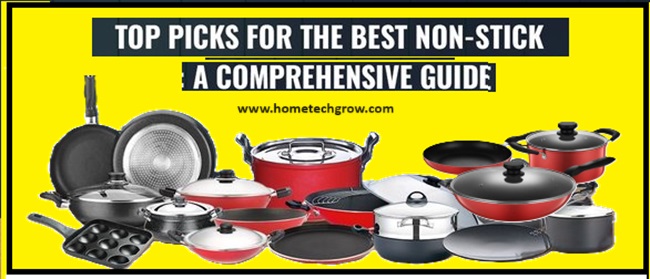What is Non-stick cookware?
- Non-stick cookware refers to pots, pans, and other cooking utensils that have a special coating applied to their cooking surface.
- This coating is designed to prevent food from sticking during cooking, making it easier to cook delicate foods like eggs, pancakes, and fish without them sticking to the pan.
- Non-stick cookware is especially useful for cooking with less oil or butter, as the non-stick surface reduces the need for excessive lubrication.
- The most common type of coating used in non-stick cookware is PTFE (Polytetrafluoroethylene), often marketed under the brand name Teflon.
- PTFE coatings provide excellent non-stick properties but can emit toxic fumes if overheated (above 500°F or 260°C), which can be harmful if inhaled. Therefore, it’s essential to use non-stick cookware at low to medium heat settings and avoid overheating
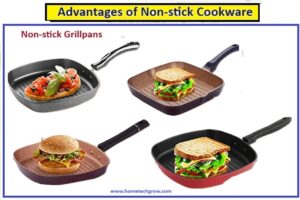
Advantages of Non-stick cookware
- Non-stick cookware offers several advantages that make it popular among home cooks and professional chefs.
- Here are some of the key advantages of using non-stick cookware:
Easy Cooking and Cleaning:
- The primary advantage of non-stick cookware is that it prevents food from sticking to the cooking surface.
- This makes it easier to cook delicate foods like eggs, pancakes, and fish without them breaking apart or sticking to the pan.
- It also reduces the need for excessive oil or butter, making meals healthier.
- it is easier to cook delicate foods like eggs, pancakes, and fish without worrying about them sticking or tearing.
Less Oil and butter Usage:
- Non-stick cookware allows you to cook with less oil or fat, as the non-stick coating reduces the amount of oil needed to prevent sticking.
- This can result in healthier meals with lower calorie and fat content.
- With non-stick cookware, you can cook with less oil or butter since the non-stick coating reduces the need for excessive lubrication. This can result in healthier cooking options with reduced fat content.
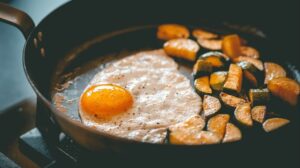
Even Cooking:
- Non-stick cookware often has good heat distribution properties, ensuring that food cooks evenly without hot spots.
- This helps in achieving consistent cooking results and prevents food from burning or undercooking in certain areas.
Versatility:
- Non-stick cookware comes in various shapes and sizes, including frying pans, saucepans, griddles, and baking sheets. This versatility allows you to use non-stick cookware for a wide range of cooking tasks, from sautéing and frying to baking and roasting.
Quick Cleanup:
- Cleaning non-stick cookware is usually quick and easy. The non-stick surface prevents food residue from sticking, making it easier to wipe clean with a sponge or cloth. Some non-stick cookware is also dishwasher-safe for added convenience.
Suitable for Low-Fat Cooking:
- Non-stick cookware is ideal for low-fat cooking methods such as grilling, stir-frying, and sautéing, as it reduces the need for excess oil or butter. This makes it a popular choice for individuals looking to reduce their fat intake without compromising on flavor.
Durable and Long-lasting:
- High-quality non-stick cookware can be durable and long-lasting with proper care and maintenance. Some non-stick coatings are scratch-resistant and can withstand regular use without deteriorating.
Wide Range of Options
- : Non-stick cookware is available in a wide range of materials, sizes, and price points, making it accessible to a diverse range of consumers with different cooking needs and budgets.
Time-Saving:
- Because food is less likely to stick to the pan, non-stick cookware can save time during cooking and cleaning, making it a convenient option for busy households.
Durability:
- High-quality non-stick cookware can be durable and long-lasting, especially when properly cared for and maintained according to the manufacturer’s instructions.
- Wide Availability: Non-stick cookware is widely available in various shapes, sizes, and price ranges, making it accessible to consumers with different preferences and budgets.
- Cooking with Less Fat: Since food doesn’t stick to the pan, you can use less fat or oil, making non-stick cookware a healthier option for cooking.
- Suitable for Beginners: Non-stick cookware is often recommended for beginner cooks or those who are new to cooking because it makes cooking and cleaning up easier and more forgiving.

- stainless cookware
Disadvantages of Non-stick cookware
- While non-stick cookware offers many advantages, it also has some potential disadvantages that users should be aware of. Here are some of the common disadvantages of non-stick cookware:
Not Suitable for High Heat:
- One of the significant drawbacks of non-stick cookware is that it is not suitable for high-heat cooking.
- The non-stick coating can break down and emit toxic fumes if exposed to temperatures above its recommended limit (usually around 500°F or 260°C).
- Overheating non-stick cookware can lead to the release of harmful chemicals, such as perfluorooctanoic acid (PFOA) and polytetrafluoroethylene (PTFE), which can be dangerous if inhaled.
Not Compatible with Metal Utensils:
- Non-stick cookware is generally not compatible with metal utensils, as they can scratch or damage the non-stick coating. I
- t’s recommended to use silicone, wood, or plastic utensils with non-stick cookware to avoid damaging the coating.
Limited Durability:
- Non-stick coatings can wear off over time, especially with frequent use and improper care. Scratching the surface with sharp objects or using abrasive cleaning tools can accelerate the deterioration of the non-stick coating, reducing its effectiveness and lifespan.
Requires Gentle Cleaning:
- Non-stick cookware requires gentle cleaning to avoid damaging the coating.
- Abrasive cleaners, scouring pads, and harsh chemicals should be avoided, as they can scratch or remove the non-stick coating, compromising its non-stick properties.
Potential Health Concerns:
- While modern non-stick coatings are generally considered safe for cooking, there have been concerns raised about the safety of certain chemicals used in older non-stick coatings, such as PFOA and PFOS.
- These chemicals have been linked to health issues when ingested or inhaled in large quantities.
- It’s essential to choose non-stick cookware with coatings that are free from harmful substances and to use them according to the manufacturer’s guidelines.
Limited Cooking Surface:
- Non-stick cookware may have a limited cooking surface due to the presence of the non-stick coating.
- This can be a drawback when cooking larger quantities of food or when using high-heat cooking methods that require a wider cooking surface.
Higher Cost:
- High-quality non-stick cookware with durable coatings can be more expensive than traditional cookware options.
- While the initial investment may be higher, it can be worth it for the convenience and ease of use that non-stick cookware offers.
- It’s essential for users to weigh the advantages and disadvantages of non-stick cookware and to choose products that suit their cooking needs, habits, and safety considerations. Proper care and maintenance can help prolong the lifespan of non-stick cookware and ensure safe and effective cooking experiences.
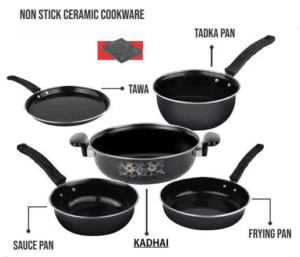
Types of Non-stick cookware
- Non-stick cookware is designed with a coating that prevents food from sticking to the surface, making cooking and cleaning easier.
- There are several types of non-stick cookware coatings available, each with its advantages and considerations. Here are some common types of non-stick cookware:
PTFE (Polytetrafluoroethylene) Coating (Teflon):
- PTFE coatings, commonly known by the brand name Teflon, are one of the most widely used types of non-stick coatings. They provide excellent non-stick properties, allowing food to slide off the surface easily.
- However, PTFE coatings can release toxic fumes if overheated (above 500°F or 260°C)
- This coating can be harmful to humans and pets.
- It’s essential to use PTFE-coated cookware at low to medium heat settings and avoid overheating.
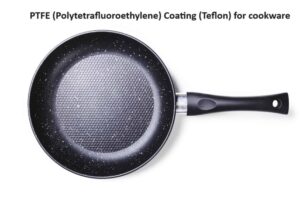
Ceramic Coating:
- Ceramic non-stick coatings are made from natural materials like sand and clay. They are considered safer than PTFE coatings because they do not emit toxic fumes at high temperatures. Ceramic-coated cookware is also scratch-resistant and easy to clean. However, ceramic coatings may not be as durable as PTFE coatings and can wear off over time, especially if not handled carefully.
Hard-Anodized Aluminum with Non-Stick Coating:
- Hard-anodized aluminum cookware is treated with an electrochemical process to create a durable and scratch-resistant surface.
- Some hard-anodized aluminum cookware is also coated with a non-stick coating, usually PTFE or ceramic.
- This combination provides the benefits of non-stick cooking along with the durability of hard-anodized aluminum.
Enamel Coating:
- Enamel-coated cookware, such as cast iron or carbon steel pans with enamel coatings, can also have non-stick properties.
- Enamel coatings are made from melted glass powder and provide a smooth, non-porous surface that resists sticking.
- However, enamel coatings may not be as slick as PTFE or ceramic coatings, and they can chip or crack if not handled carefully.
Diamond-Infused Coating
- Some newer non-stick cookware features a diamond-infused coating that is touted as more durable and scratch-resistant than traditional non-stick coatings.
- These coatings often combine elements of ceramic and diamond particles for enhanced non-stick performance.
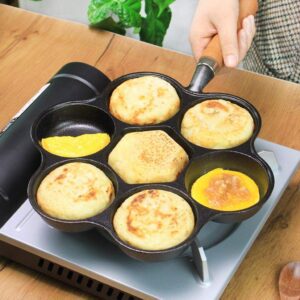
Other Non-stick Cookware: Steel and Aluminium Coating
- Non-stick cookware can be made from various materials, including:
- Aluminum:
- Lightweight and conductive, aluminum is commonly used for non-stick cookware.
- However, it’s often coated with a non-stick coating due to aluminum’s reactive nature with acidic foods.
- Stainless Steel:
- Stainless steel non-stick cookware is typically layered with a non-stick coating to prevent food from sticking.
- This combination provides the benefits of stainless steel’s durability and the convenience of non-stick cooking.
- Cast Iron:
- Cast iron cookware can also be coated with a non-stick material, such as enamel or ceramic.
- These coatings enhance the non-stick properties of cast iron while retaining its heat retention and distribution capabilities.
- Hard-Anodized Aluminum:
- Hard-anodized aluminum cookware undergoes an electrochemical process to create a durable, non-reactive surface. It’s often coated with a non-stick material for added convenience.
- When selecting cookware for cooking, there are several factors to consider to ensure that you choose the right options for your needs.
- When selecting cookware, consider the following tips:
-
- Match the cookware material to your cooking needs and preferences (e.g., non-stick for easy cleanup, cast iron for searing and braising).
- Choose cookware that is compatible with your stove type (e.g., induction-ready cookware for induction stoves).
- Invest in high-quality cookware that will last longer and provide better cooking performance.
- Consider the maintenance requirements of each type of cookware and choose one that fits your lifestyle.
- Ultimately, the best cookware for you will depend on your cooking habits, budget, and personal preferences.
- It’s often helpful to have a mix of different types of cookware to accommodate various cooking techniques and recipes.
- Here are some tips for selecting cookware:
Choose the correct Material:
- Select proper materials for you cooking methods ( gas, induction and micro wave heating) in kitchen
- Stainless Steel Cookware:
- Pros: Durable, non-reactive (doesn’t react with acidic foods), easy to clean, and retains heat well.
- Cons: Can be more expensive, and may not have non-stick properties (food may stick if not properly seasoned or with low-quality stainless steel).
- Non-Stick Cookware:
- Pros: Easy to clean, requires less oil for cooking, ideal for cooking delicate foods like eggs and pancakes.
- Cons: Not as durable as stainless steel, can be damaged by metal utensils, may release harmful fumes if overheated.
- Cast Iron Cookware:
- Pros: Excellent heat retention, naturally non-stick when properly seasoned, adds iron to your food.
- Cons: Heavy, requires seasoning and maintenance to prevent rust, not suitable for acidic foods for long periods.
- Copper Cookware:
- Pros: Excellent heat conductivity, heats up and cools down quickly, attractive appearance.
- Cons: Expensive, requires regular polishing to maintain appearance, may react with acidic foods.
- Aluminum Cookware:
- Pros: Lightweight, conducts heat well, affordable.
- Cons: May react with acidic foods, can warp or dent easily, not as durable as other materials.
- Clay or Ceramic Cookware:
- Pros: Retains moisture well, enhances flavors, non-reactive.
- Cons: Can be fragile, may require special care to avoid cracking, not suitable for high-heat cooking.
Select Compatibility with Shape, Size:
- Ensure that the cookware is compatible with your cooking appliance (gas stove, electric stove, induction cooktop, etc.).
- Size and Shape:
- Choose cookware sizes and shapes that match your cooking needs.
- For example, a larger pot for boiling pasta or a smaller skillet for sautéing vegetables.
Safety with Handles and lids:
- Look for sturdy, heat-resistant handles that are comfortable to grip and securely attached to the cookware.
- Lids: Select cookware with tight-fitting lids to help retain moisture and heat during cooking.
Maintenance:
- Consider the ease of cleaning and maintenance for the type of cookware you choose.
Budget:
- Determine your budget and prioritize quality and durability when making your selection.
Cooking Style:
- Consider your cooking style and the types of dishes you frequently prepare.
- For example, if you often sear meats, a cast iron skillet may be beneficial.
Health and Safety:
- Choose cookware that is free from harmful chemicals and materials that can leach into food during cooking.
- By considering these factors, you can select cookware that suits your cooking preferences, budget, and lifestyle while ensuring efficient and enjoyable cooking experiences.
Summary
- When choosing non-stick cookware, consider factors such as cooking habits, heat tolerance, durability, and safety.
- It’s important to follow the manufacturer’s instructions for use and maintenance to prolong the lifespan of non-stick cookware and ensure safe cooking practices.
- .Despite these advantages, it’s essential to use non-stick cookware responsibly and follow the manufacturer’s guidelines to ensure its longevity and safety.
- Overheating non-stick cookware can release harmful fumes, so it’s crucial to use them at recommended heat levels and avoid using metal utensils that can scratch the non-stick coating
- It’s essential for consumers to be aware of potential toxic cookware materials and to choose cookware that is made from safe and non-toxic materials.
- Look for cookware that is labeled as free from harmful substances such as PFOA, PTFE, lead, cadmium, and other toxic chemicals. Additionally, proper use, care, and maintenance of cookware can help minimize the risk of exposure to harmful substances.
